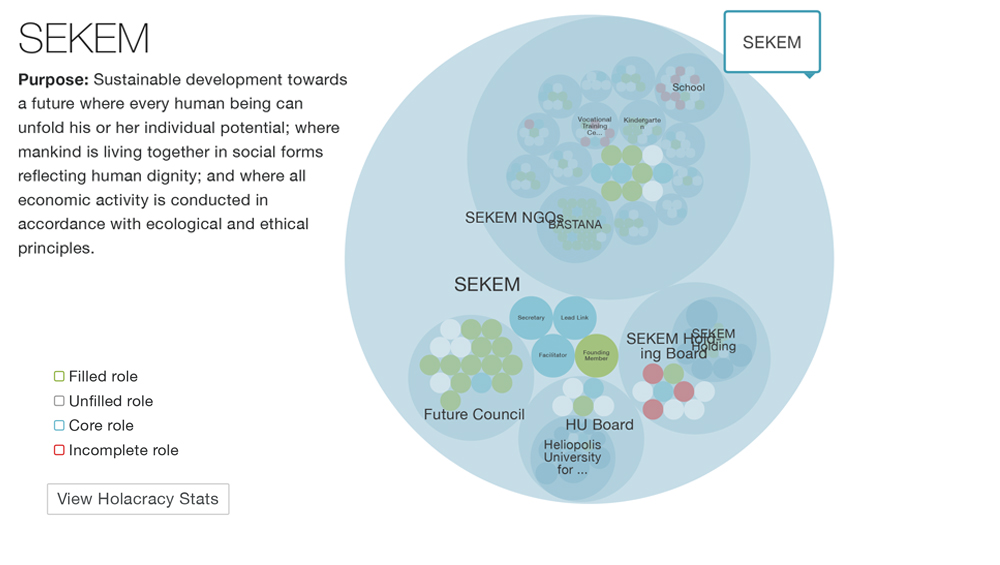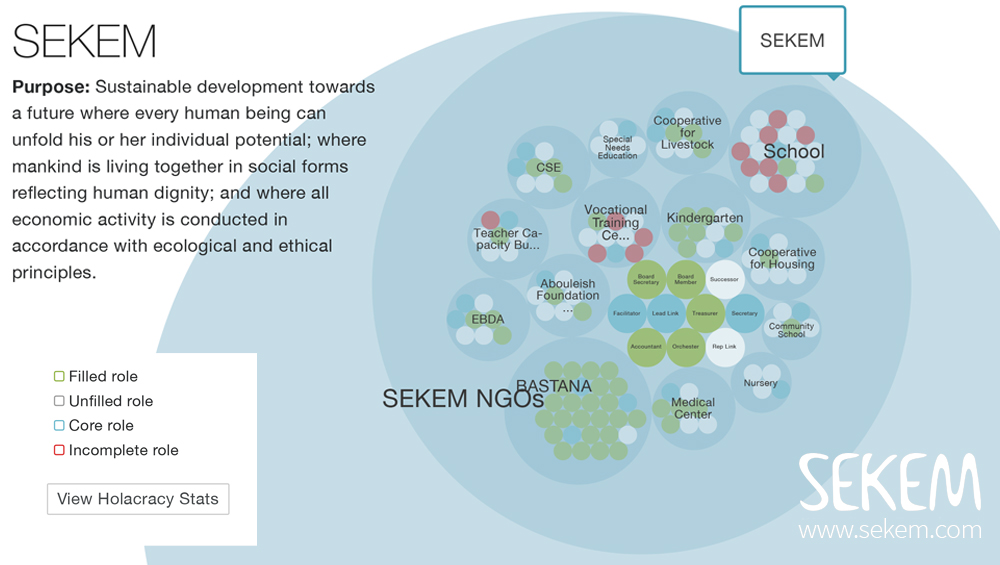After the death of SEKEM founder Ibrahim Abouleish, a restructuring process has begun which SEKEM named SEKEMsophia. The following report is part of a series of articles by which SEKEM wants to update all its friends and partners in regard to the developments of this process.
When looking at typical organizational charts of companies, we easily get reminded to trees: the typical SEKEM Casuarina trees, or European Christmas trees that during this time of the year get decorated with glitter baubles and a shiny star at the top. But, these tree models do not represent how things really work and often they are not up-to-date. The informal organization and decision making dynamics behind the official titles differ from what is written on paper – not only in Egypt and not only at SEKEM.
Helmy Abouleish, as the newly appointed chairperson from all SEKEM associations and NGOs, just recently reviewed the institutional setting of SEKEMs cultural life. New board members for all NGOs have been assigned that actually work and live at SEKEM (also coming from the younger generation) and are directly connected to the purpose of the respective entities. All activities and governance structures are made visible with the help of “glassfrog”, a software that supports the project landscape visualization among other things. How does this change the flow and spirit of work at SEKEM?

Every circle and every role has a clear purpose (its reason of existence) and accountabilities (what others can expect from that role/circle) and sometimes domains (something that the role/circle controls). In so-called tactical meetings,, all projects from each circle and role are mapped and important checklist items or metrics are analysed. A circle does not necessarily represent a legal entity. This is why for example all NGOs are put in the SEKEM NGOs circle, who has several sub-circles that have each a distinctive purpose. Here we find all department from the SEKEM Development Foundation but also other entities such as the Egyptian Biodynamic Farmers Association.

“What we used to do implicitly before becomes explicit and structured. In the beginning, I did not feel comfortable at all with this degree of formality and transparency. But more and more, I can see a sense behind this clarity and discipline even though it will never replace needed inter-personal space for building trust and relationship and exchanging some gossip.”
Yvonne Floride, lecturer for arts at SEKEM School and Heliopolis University
Getting a feeling for SEKEMs complexity
Seeing the enitre SEKEM initiative from the bird’s eye perspective in concentric circles feels much more natural for me than just having a collection of separated box-trees on paper with job descriptions. This governance structure is not static, it is alive and can become a real-time reference for our every-day orientation. It took us more than a year until the structure became what it is today. And every week there are some new changes.
“Now, the people of SEKEM NGOs circle see each other regularly and thereby become more aware of the cultural activities. It is very helpful for the overall understanding of SEKEM.”
Dr. Mohamed Al Zahar, Lead Link Medical Center
Embracing this new perspective, we get a feeling of the bigger picture of SEKEM and bring details to the light that were out of focus before.
Dividing roles from souls
Having this visualized structure and clarity on the different purposes and accountabilities was enlightening for many SEKEM members, although the transparency was difficult to reach. SEKEMs current success is rooted in a strong pioneer culture marked by high degrees of improvisation, informal organization and strong leadership from the top. While keeping these elements in place as needed, we think that more clarity in the scope of responsibility of others cannot cause any harm. On the contrary, it can be encouraging and engaging if one clearly knows what is expected from oneself and what one can expect from others – and interestingly enough the inner commitment might benefit as well. From this increased awareness for the structure of the organisation as a whole and our part in it, individual motivation and bonding to work will grow.
“In SEKEM the temptation to work on 100 different things simultaneously and the chance of getting distracted from a powerful focus is high. The real challenge lies in saying NO to things we could do, in order to stick to our core commitments.”
Thomas Abouleish, Chief Relations Officer, SEKEM
Finding out, where we have a lack of capacity (unfilled roles and lack of people or people’s capacity) or unclarity (lack of roles or accountabilities), will allow us to adjust to the respective structural need for serving SEKEMs purpose. Doing things beyond our roles and accountabilities may seem heroic on the one hand. But on the other hand, it actually deprives SEKEMs governance structure to evolve. We have to learn to be clear about these kind of tensions and dare to voice them without the fear of personal conflict because in the organizational context we should be mature enough to seperate our roles from our personal issues.
“Self-management and serving a higher purpose as opposed to being managed and serving an authority is a question of consciousness development.”
Helmy Abouleish, CEO SEKEM
For some people, a role might be exactly the same like a job description and a circle the same like a department or organization. Indeed, some personalities do need a strong leader that tells them what to do. But for sure, many would do a much better job if they were clear about what is exactly expected from them and how success is measured. What if we make sure that we build healthy habits of regularly checking on important things? What if we create resilient systems that can compensate for a lack of consciousness? How can we ensure to foster clarity, efficiency and accountability and in the same time foster human development, participatory elements and a culture of devotion toward SEKEM?
The wind of change is blowing
With the help of “glassfrog” a new momentum is arising and over the course of time a new culture can be created. The first joint board meeting of all SEKEM NGOs was held on 29th of July 2017. All new appointed board members came together in order to review the current reality of our governance structure and ongoing projects. During the subsequent months all entities created their own objectives and key results for the next quarter aiming at setting transparent priorities. Since then, all SEKEM NGOs subcircle members are meeting on a monthly basis to keep the leadership team in sync. Our plan is, that each subcircle will have further regular weekly meetings that will not only sharpen accountability but also promote interpersonal encounters.

Since Helmy Abouleish replaced his father and became lead link of all NGOs a breath of fresh air blows into SEKEMs cultural life. Coming more from the realm of economic life, Helmy Abouleish brings new potential of creating a momentum for change. The increased clarity and transparency on projects and numbers encourages people to take more active responsibility in their respective fields. Still, the rhythm and basic DNA of cultural life needs freedom and a circular approach to development, which brings us back to the image of concentric circles as a representation of a purposeful organization. So, when we think again of the Casuarina trees, or in Europe the decorated Christmas tree, let us not focus only on its pyramid shape or the glitter baubles and the shiny star at the top but rather admire its organic form and structural alignment, where each little fir needle serves a higher purpose.
Maximilian Abouleish-Boes
SEKEMsophia – The Phoenix Out of the Ashes
SEKEM Holding Structure

